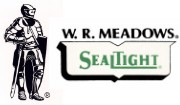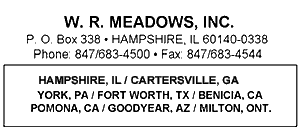| |

NO. 397-PD
SEALTIGHT POLY-GRIP
TWO-COMPONENT, POLYESTER BASED ANCORING ADHESIVE,
UNITIZED CARTRIDGE SYSTEM
DESCRIPTION
Two-component, non-sag, polyester-based, very rapid curing and hardening, high
strength, structural anchoring packaged in a unitized cartridge system.
USES
The product is ideal for structural anchoring and doweling in a wide range of
temperatures (20°F (7.0°C) - 100°F (37.8°C). This product is suitable for
interior or exterior applications, industrial, residential and civil engineering
applications. The very rapid hardening properties of SEALTIGHT POLY-GRIP ensure
minimum downtime and quick bolt-up time.
FEATURES / BENEFITS
 | Very Rapid Hardening / Minimum Bolt-Up time at 75° F
is 1 Hour
 | Use Range of 20°F (7.0°C) - 100°F (37.8°C) / Wide
Range of Application
 | Requires no Conditioning to Tight Temperature Range /
Rapid Dispensing Rate Through Application Range
 | Highly Engineered / Added Dynamic Stability
 | Very Forgiving Mix Ratio / Greatest Level of Job-Site
Reliability
 | Suitable for Hollow Block / Designed to be Compatible
with Screen Systems
 | Moisture Insensitive When Cured / Suitable for Damp
Environments
 | Non-Sag / Minimizes Waste |
| | | | | | |
TECHNICAL DATA
| Color: |
Gray |
| Mix Ratio (A to B) |
10:1 |
| Consistency ASTM C 881 |
Non-Sag |
Pot Life @ 75°F (23.9°C)
ASTM C 881 |
5-10 Min. |
Pot Life @ 35°F (1.7°C)
ASTM C 881 |
75-105 Mins. |
COMPLIMENTARY REPAIR / RENOVATION PRODUCTS
 | MEADOW-CRETE GPS, All-purpose, polymer-modified, hand
or spray applied structural repair mortar
 | MEADOW-CRETE FNP, One-component, flowable, form and
pour repair mortar for structural applications
 | FUTURA-15 & 30, rapid-hardening repair mortars
 | MEADOW-PATCH T-1 & T-2, polymer modified thin
repair mortars
 | MEADOW-PATCH 5 & 20, All-purpose, rapid-setting
repair mortar
 | MEADOW-PLUG, Super fast setting, hydraulic repair
mortar
 | MEADOW-COAT, Waterproofing, decorative, cementitious
thin coating
 | REZI-WELD EPOXIES, Full line of repair epoxies |
| | | | | | |
SHELF LIFE
9 months when stored on pallets in a dry, cool area.
YIELD
28 fl. Oz. Cartridge yields 50.53 in³ (828 ml.)
ULTIMATE PULL-OUT & SHEAR STRENGTH VALUES
(Test Concrete F’c=2000 psi.)
| |
|
|
Threaded Rod |
Rebar |
Anchor Rod
Diameter (Inches) |
Hole Diameter
(Inches) |
Embedment Depth
(Inches) |
Tensile Load
(lbs.) |
Shear Load
(lbs.) |
Tensile Load
(Lbs.) |
|
3/8 |
7/16 |
3 – 3/8 |
4,200 |
Not Tested |
Not Tested |
|
1/2 |
9/16 |
4 – 1/2 |
12,000 |
9,000 |
13,250 |
|
5/8 |
3/4 |
5 – 5/8 |
13,500 |
15,500 |
14,500 |
|
3/4 |
7/8 |
6 – 3/4 |
17,250 |
22,500 |
15,750 |
|
7/8 |
1 |
7 – 7/8 |
25,000 |
32,500 |
30,000 |
|
1 |
1 – 1/4 |
9 |
27,500 |
41,500 |
44,500 |
Testing was performed in
accordance with ASTM E 488-96 and ICBO AC58.
Testing used B7 threaded rod and Grade 60 rebar. All physical properties
are laboratory based, onsite testing may result in different values due
to environmental, mixing, variations in concrete strength and curing
temperatures. |
APPLICATION PROCEDURE
Anchoring / doweling configurations / designs must be approved by a qualified
Professional Engineer. Drill hole to proper diameter and length. In most cases,
the diameter of the hole should be no more than 1/8 inch larger than anchor
diameter. Using oil-free compressed air, blow out dust from bottom of the hole
again. The hole should be clean of dust and debris and should be dry to obtain
optimal properties.
Insert cartridge into the gun with label-side down. Remove
plastic band and black caps from cartridge. Dispense a small amount of SEALTIGHT
POLY-GRIP into a disposable container until you get an even flow of black and
white material.
Place nozzle onto cartridge and then slide nut over nozzle
and thread the nut into cartridge. Make sure that the nozzle, nut and cartridge
assembly is secure. Dispense enough SEALTIGHT POLY-GRIP into a disposable
container until the color becomes consistent gray with not streaks.
Dispense SEALTIGHT POLY-GRIP starting from the bottom of
the hole. Fill hole approximately 5/8 of the depth while slowly withdrawing the
nozzle. While dispensing make sure that SEALTIGHT POLY-GRIP is not leaking from
cartridge.
If this occurs, discontinue use immediately and continue
to work with new cartridge and nozzle.
Insert the threaded rod, rebar or dowel to the bottom of
the hole while turning clockwise. The threaded rod, rebar or dowel should be
free of dirt, grease, oil, or other foreign materials. Do not disturb or
bolt-up until minimum bolt-up time has passed.
LIMITATIONS
Do not apply SEALTIGHT POLY-GRIP when the
temperature is expected to be below 20°F (7°C) or above 100°F (37.8°C)
within 24 hours or when rain is imminent. Requires dry substrate for maximum
performance. Anchor / Dowel Hole diameter must not be ¼" greater than
Anchor / Dowel diameter. For industrial use only by Professional Contractors.
SAFETY and TOXICITY
Avoid direct contact with this material. Eye contact may result mild to moderate
irritation. Skin contact may result in mild to moderate irritation. Inhalation
may cause respiratory tract irritation. Skin and eye sensitization may occur in
susceptible individuals. Ingestion may result in mild to moderate irritation of
the gastrointestinal tract. Refer to Material Safety Data Sheet for complete
Health and Safety Information.
This material last updated June, 2001.


LIMITED WARRANTY
W.R.MEADOWS,INC. warrants that at the time and place we make shipment, our
material will be of good quality and will conform with our published
specifications in force on the date of acceptance of the order. Read complete
warranty. Copy furnished upon request.
Disclaimer
The information contained herein is included for illustrative purposes only, and
to the best of our knowledge, is accurate and reliable. W.R.MEADOWS,INC. cannot
however under any circumstances make any guarantee of results or assume any
obligation or liability in connection with the use of this information. As
W.R.MEADOWS, INC. has no control over the use to which others may put its
product, it is recommended that the products be tested to determine if suitable
for specific application and/or our information is valid in a particular
circumstance. Responsibility remains with the architect or engineer, contractor
and owner for the design, application and proper installation of each product.
Specifier and user shall determine the suitability of
products for specific application and assume all responsibilities in connection
therewith.

|